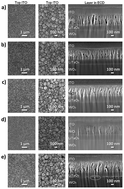Life-cycling and uncovering cation-trapping evidence of a monolithic inorganic electrochromic device: glass/ITO/WO3/LiTaO3/NiO/ITO
Abstract
The visualization of the microstructure change and of the depth of lithium transport inside a monolithic ElectroChromic Device (ECD) is realized using an innovative combined approach of Focused Ion Beam (FIB), Secondary Ion Mass Spectrometry (SIMS) and Glow Discharge Optical Emission Spectroscopy (GDOES). The electrochemical and optical properties of the all-thin-film inorganic ECD glass/ITO/WO3/LiTaO3/NiO/ITO, deposited by magnetron sputtering, are measured by cycling voltammetry and in situ transmittance analysis up to 11 270 cycles. A significant degradation corresponding to a decrease in the capacity of 71% after 2500 cycles and of 94% after 11 270 cycles is reported. The depth resolved microstructure evolution within the device, investigated by cross-sectional cutting with FIB, points out a progressive densification of the NiO layer upon cycling. The existence of irreversible Li ion trapping in NiO is illustrated through the comparison of the compositional distribution of the device after various cycles 0, 100, 1000, 5000 and 11 270. SIMS and GDOES depth profiles confirm an increase in the trapped Li content in NiO as the number of cycles increases. Therefore, the combination of lithium trapping and apparent morphological densification evolution in NiO is believed to account for the degradation of the ECD properties upon long term cycling of the ECD.



 Please wait while we load your content...
Please wait while we load your content...